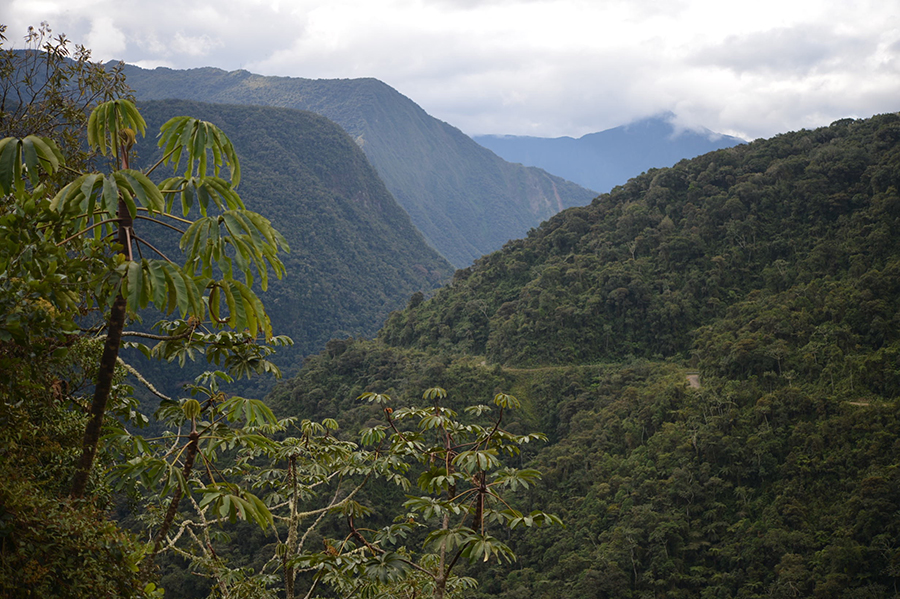
Photo, Alexandre Antonelli.
Mountains are among the most biologically diverse places on Earth, but scientists have struggled to fully understand why they are so important in creating high species richness. An international research team led by Alexandre Antonelli from the University of Gothenburg has now shed new light on answering this long-standing question.
The team found that mountain building, through a process of uplift and erosion, continuously reshapes the landscape and is responsible for creating habitat heterogeneity along mountain slopes.
‘The high variation of habitats and climate, from warm forest-covered valleys to cold tree-free summits, is tightly linked to high biological diversity’, says Alexandre Antonelli.
‘The complex interplay between growing mountains and climate generates plenty of opportunities for the creation of new species’, says Carina Hoorn from the University of Amsterdam, senior author of the paper.
Geological history plays a role
Although climate and ruggedness of the terrain were previously thought to be the principal cause for mountain biodiversity, the authors’ global synthesis now makes clear that geological history plays a paramount role in promoting speciation.
The team reached this conclusion by applying statistical models to biological, geological and climatological datasets from across the globe. The authors related the species richness of birds, mammals and amphibians to global datasets of temperature, precipitation, erosion rates, relief and soil composition.
‘I was surprised to find not only the usual correlations with climate, but a significant relation between biodiversity, erosion history, relief and number of soil types’, says Daniel Kissling who conducted the statistical analyses of the paper. While the study shows that this is evident globally, it also revealed that the relationship can vary depending on which mountain system is considered.
Other possible factors
The study further showed that geographic position (e.g. whether a mountain intercepts atmospheric currents or not) and how long ago the mountain formed are also important factors influencing biodiversity in mountains. On shorter geological time scales, Quaternary climatic fluctuations can also promote the creation of new species in mountains.
‘We suggest that the waxing and waning of glaciers, which has strongly reshaped the landscape and repeatedly connected and disconnected animal and plant populations, has played an important role for the creation of new mountain species’, says Suzette Flantua who studied the effects of Quaternary climate change in the Andes.
 “It’s so exciting that we found so strong correlations and clear insights. The key was a close collaboration between biologists and geologists, which is quite unusual. I hope that this study will encourage more researchers to collaborate across the disciplines to better understand how biodiversity evolved and how it will respond to on-going climatic and landscape changes”, concludes Alexandre Antonelli.
“It’s so exciting that we found so strong correlations and clear insights. The key was a close collaboration between biologists and geologists, which is quite unusual. I hope that this study will encourage more researchers to collaborate across the disciplines to better understand how biodiversity evolved and how it will respond to on-going climatic and landscape changes”, concludes Alexandre Antonelli.
Contact:
Professor Alexandre Antonelli, Department of Biological and Environmental Sciences, and Director of the Gothenburg Global Biodiversity Centre:
alexandre.antonelli@bioenv.gu.se [in Brazil between 1-9 October but available by e-mail, or phone/skype contact upon agreement]
Publication details:
Antonelli, A., Kissling, W.D., Flantua, S.G.A., Bermúdez, M.A., Mulch, A., Muellner-Riehl, A.N., Linder, H.P., Badgley, C., Fjeldså, J., Fritz, S.A., Rahbek, C. Herman, F., Hooghiemstra, H. & Hoorn, C. (2018): Geological and climatic influences on mountain biodiversity. Nature Geoscience, DOI: 10.1038/s41561-018-0236-z
https://doi.org/10.1038/s41561-018-0236-z
Web links:
https://rdcu.be/8eEP
https://www.nature.com/articles/s41561-018-0236-z.epdf?author_access_token=XWKrOEpCG34_J_oEsWQJG9RgN0jAjWel9jnR3ZoTv0PDVbfo4u9r2amlOYjROSSxn2MKstDER6PWAAEtxRat6a2WLtsSmqQuHbhLHQUmfsIJkLhAWjMtXSjcEVLTQbi-K6FH_Q5eZEisQpFBJaSYew%3D%3D
Gothenburg Global Biodiversity Centre: http://www.ggbc.gu.se
Alexandre Antonelli’s research group: http://antonelli-lab.net
Images:
Representative images of mountains and some of the authors are available free for publication from: http://tiny.cc/NG_2018_photos

 “It’s so exciting that we found so strong correlations and clear insights. The key was a close collaboration between biologists and geologists, which is quite unusual. I hope that this study will encourage more researchers to collaborate across the disciplines to better understand how biodiversity evolved and how it will respond to on-going climatic and landscape changes”, concludes Alexandre Antonelli.
“It’s so exciting that we found so strong correlations and clear insights. The key was a close collaboration between biologists and geologists, which is quite unusual. I hope that this study will encourage more researchers to collaborate across the disciplines to better understand how biodiversity evolved and how it will respond to on-going climatic and landscape changes”, concludes Alexandre Antonelli.